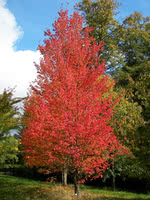Mon-Fri 9am - 5pm Mountain time
Common Hackberry vs Red Maple
Celtis occidentalis
Acer rubrum
The Common Hackberry is a medium-sized deciduous tree that resembles the American Elm but is immune to Dutch Elm Disease. They are versatile and can adapt to a variety of growing conditions.
It produces purple-red, berry-like fruit with a large seed in the center. Both the sweet flesh, which tastes similar to dates, and the crunchy seed are edible. The fruit remains on the tree throughout the winter, offering a valuable food source for birds and other wildlife.
The Common Hackberry can also be a great addition to a pollinator garden. The tree itself is a host for the larvae of several butterfly species and the flowers provide a source of pollen and nectar.
Red Maple is a beautiful deciduous tree that blooms with small red flowers in the spring. It is one of the first trees to change colour in the fall, turning a brilliant reddish-orange colour. It is one of the most common and widespread maples in North America.
Red Maple is a great choice for parks and large gardens where there is ample room for its root system.
Important note: Red Maple leaves are toxic to horses if ingested in quantity.
Common Hackberry Quick Facts
Red Maple Quick Facts
Toxicity: wilted leaves toxic to horses
In row spacing: 2.4 - 4 m (8 - 12 ft)

